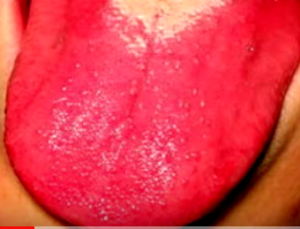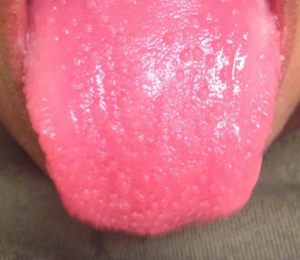It may be noted that strawberry tongue is not the same as glossitis which is general tongue inflammation that often sports a shiny and smooth tongue, unlike the uneven appearance of a strawberry tongue.
Strawberry tongue is marked by enlarged fungiform papillae. Hence, in addition to increased redness of the tongue, the organ also features a scattering of elevated papillae which makes it look like a strawberry. The condition may cause the tongue to be reddish or whitish. Sometimes, it is also termed as ‘raspberry tongue.
Causes of strawberry tongue
A strawberry tongue is usually a symptom of some pre-existing systemic illness rather than some kind of oral condition. Some of possible causes are listed below:
- Measles: It is a viral infection that affects children and is marked by runny nose, cough, red strawberry tongue, distinctive skin rash, and fever. The disease is self-limiting and treatment is carried out as per the symptoms.
- Kawasaki disease: This condition is found in young children and infants. The disease causes inflammation in blood vessels and some arteries in the body. Strawberry tongue is regarded as one of the primary symptoms of Kawasaki disease. Patients may also exhibit additional symptoms like high fever, redness in soles and palms, peeling skin, inflammation of lymph nodes, goopy red eyes, and rash on skin.
- Vitamin deficiency: Another common cause of strawberry tongue is deficiency of nutrients like folic acid and vitamin B12. Anemia may be caused if these vitamins are not present in normal levels. Patients are also increasingly at risk to suffering from different kinds of other ailments. Supplements and diet and lifestyle changes can help overcome the deficiency.
- Drug and/or food allergies: Sometimes, an allergic reaction to some food or certain medicines that you may have consumed can result in development of strawberry tongue. Vegetables and fruits are usually the most common causes. Redness and swelling associated with allergic reaction can be alleviated with antihistamines.
- Scarlet fever: Scarlet fever is a bacterial infection that typically affects children in the age group of 5 to 15 years. It is usually caused due to worsening of an underlying case of strep throat. The most distinctive symptom of scarlet fever is a reddish rash which appears almost all over the body. Patients may also suffer from symptoms like a flushed face, strawberry tongue, red lines in skin creases, headache, high fever, swallowing problems, and sore throat, etc. Non-treatment can result in serious health complications and hence timely medical treatment is vital.
- TSS/Toxic shock syndrome: It is an uncommon cause of strawberry tongue. It is usually a life-threatening reaction or side effect of some kinds of bacterial infections. Most instances of TSS are related to use of tampons, but some cases have also been found to be the effect of nasal packing, i.e. use of gauze within the nasal chambers to stop bleeding. Patients may also experience symptoms like headache, sudden high fever, aches, sore throat, nausea, pains, diarrhea, and vomiting. People who think that they may have TSS need to seek immediate medical attention.
Geographic tongue is a harmless oral condition, wherein the tongue looks like map. Some areas of the tongue may exhibit enlarged papillae and redness while other areas may have a thick whitish coating. Even though the tongue appears like a strawberry tongue, geographic tongue is an altogether different oral ailment.
Strawberry Tongue – Pictures
Treatment of strawberry tongue
As discussed above, strawberry tongue is not an illness by itself, but rather a symptom of some underlying disease. Hence, treatment is focused on diagnosis of the pre-existing condition and then curing it as per standard medical procedures.
A few treatment options are listed below:
- Kawasaki disease is self limiting in nature. However, non-treatment can result in thinning or bulging of walls of the arteries which supply blood to the cardiac muscle, or it can cause other kinds of damage to the coronary arteries; this can be life-threatening and hence treatment is essential. Doctors may suggest immunoglobulin therapy and aspirin to alleviate inflammation.
- Scarlet fever is usually treated with antibiotics. Early detection and subsequent treatment with antibiotics can help ease the symptoms such as strawberry tongue, etc. Prompt treatment can help prevent the onset of complications of scarlet fever like rheumatic fever.
- Folic acid and vitamin B12 deficiency can be treated with intake of a healthy and balanced diet along with supplements as suggested by a doctor.


